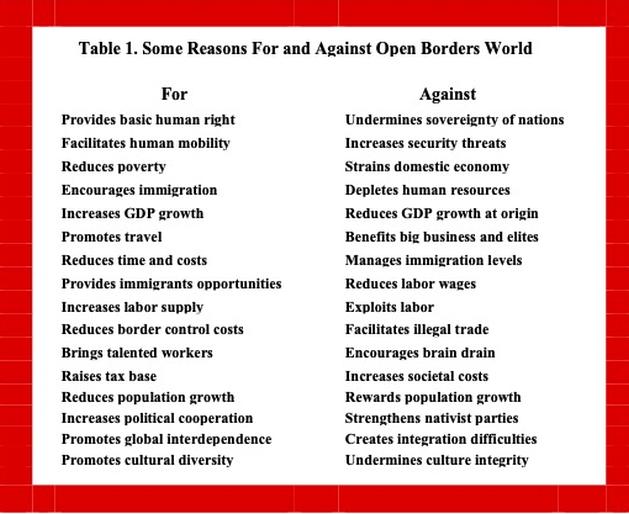An Open Borders World
 10 Juni 2022
10 Juni 2022

In virtually every region, governments appear to be at a loss on how best to address international migration, especially the waves of illegal migration arriving daily at international borders and the many already residing unlawfully within their countries. Credit: Alexander Bee/OIM
By Joseph Chamie
PORTLAND, USA, Jun 9 2022 (IPS)
A world with open borders, as some strongly advocate while others insist on maintaining controlled borders, is an interesting exercise to consider given its potential consequences for nations, the planet’s 8 billion human inhabitants, climate change, and the environment.
Based on international surveys of 152 countries taken several years ago before the COVID-19 pandemic, approximately 15 percent of the world’s adults said that they would like to migrate permanently to another country if they could. Based on that percentage for adults plus their family members, the estimated number of people who want to migrate in 2022 is likely to be no less than 1.5 billion.
Seven destination countries attract half of those wanting to migrate to another country. The top destination country at 21 percent of those wanting to migrate is the United States. Substantially lower, Canada and Germany are next at 6 percent, followed by France and Australia at 5 percent, the United Kingdom at 4 percent, and Saudi Arabia at 3 percent
The figure of 1.5 billion wanting to migrate is more than 5 times the estimated number of immigrants in the world in 2020, or about 281 million. The figure of potential immigrants is also approximately 500 times the annual flow of immigrants globally.
The two regions with the highest proportions wanting to migrate to another country if they had the chance are sub-Saharan Africa at 33 percent and Latin America and the Caribbean at 27 percent. In addition, in 13 countries at least half of their populations would like to migrate to another country.
The top three countries with the proportion of their adult populations wanting to migrate are Sierra Leone at 71 percent, Liberia at 66 percent, and Haiti at 63 percent. They are followed by Albania at 60 percent, El Salvador at 52 percent, the Democratic Republic of the Congo at 50 percent.
Seven destination countries attract half of those wanting to migrate to another country. The top destination country at 21 percent of those wanting to migrate is the United States. Substantially lower, Canada and Germany are next at 6 percent, followed by France and Australia at 5 percent, the United Kingdom at 4 percent, and Saudi Arabia at 3 percent.
Among those seven destination countries, the numbers wanting to migrate are greater than the current populations of five of them. For example, the number of people wanting to migrate to Canada is 90 million versus its current population of 38 million. Similarly, the number wanting to migrate to Germany is 94 million versus its current population of 84 million. In the remaining two countries, the United States and the United Kingdom, the numbers wanting to migrate are nearly the same size as their current populations (Figure 1).
In addition to its impact on the size of populations, open borders would alter the ethnic, religious, and linguistic composition of populations, leading to increased cultural diversity. Past and present international migration flows have demonstrated alterations in the cultural composition of populations.
In the United States, for example, since 1965 when the Immigration and National Act on country of origin was passed, the proportion Hispanic increased nearly five-fold, from 4 percent to 19 percent in 2020, and the proportion non-Hispanic white declined from 84 percent to 58 percent. Similarly in Germany, the proportion Muslim since 1965 has increased five-fold, from less than 1 percent to 5 percent of the population in 2020.
Various reasons have been offered both in support and in opposition to an open borders world. For example, those opposed believe open borders would increase security threats, damage domestic economies, benefit big business and elites, increase societal costs, encourage brain drain, facilitate illegal trade, reduce labor wages, undermine cultural integrity, and create integration problems (Table 1).
In contrast, those in support believe open borders would provide a basic human right, reduce poverty, increase GDP growth, reduce border control costs, increase the labor supply, provide talented workers, promote travel, reduce time and costs of travel, raise a country’s tax base, promote cultural diversity, and contribute to global interdependence.
Open borders would certainly impact the cultural composition of populations. Even without open borders, the current changes in the cultural composition of populations being brought about by international migration have not only raised public concerns but have also contributed to the growing influence of nativist and far-right political parties.
The nativist parties are typically opposed to immigration, seeing it as a threat to their national cultural integrity. In contrast, those supportive of immigration welcome the arrival of people with differing backgrounds, ethnicities, and cultures. They view immigration it as a natural, ongoing human phenomenon that enriches societies.
Open borders would also have consequences on climate change and the environment. Large numbers of people would be migrating to countries with high levels of greenhouse gas emissions per capita. For example, while the world average of tons of CO2 equivalent per person is about 6, the level in the United States is about three times as large at 19.
Similarly, open borders would impact the environment. The migration to the high consumption destination countries would lead to increased biodiversity loss, pollution, and congestion.
An open borders world is not likely to happen any time soon. However, recent large-scale immigration flows, both legal and illegal, are substantially impacting government programs, domestic politics, international relations, and public opinion as well as the size and composition of the populations.
In virtually every region, governments appear to be at a loss on how best to address international migration, especially the waves of illegal migration arriving daily at international borders and the many already residing unlawfully within their countries. International conventions, agreements, and compacts concerning international migration are largely viewed as being outdated, unrealistic, and ineffective in dealing with today’s international migration issues.
The supply of men, women, and children in poor developing countries wanting to migrate greatly exceeds the demand for those migrants in wealthy developed countries by a factor of about five hundred.
The result is the Great Migration Clash, i.e., a worldwide struggle between those who “want out” of their countries and those who want others to “keep out” of their countries.
Given the enormous difference in supply and demand, the Migration Clash is unlikely to be resolved by simply asking destination countries to raise their immigration levels. To resolve the Migration Clash will require considerably improving the social, economic, political, and environmental conditions of the populations in the migrant sending countries.
Achieving those desirable development goals any time soon, however, appears as unlikely as establishing an open borders world. Therefore, countries will continue dealing the best they can with the consequences of controlled borders and the Great Migration Clash.
Joseph Chamie is a consulting demographer, a former director of the United Nations Population Division and author of numerous publications on population issues, including his recent book, “Births, Deaths, Migrations and Other Important Population Matters.”


